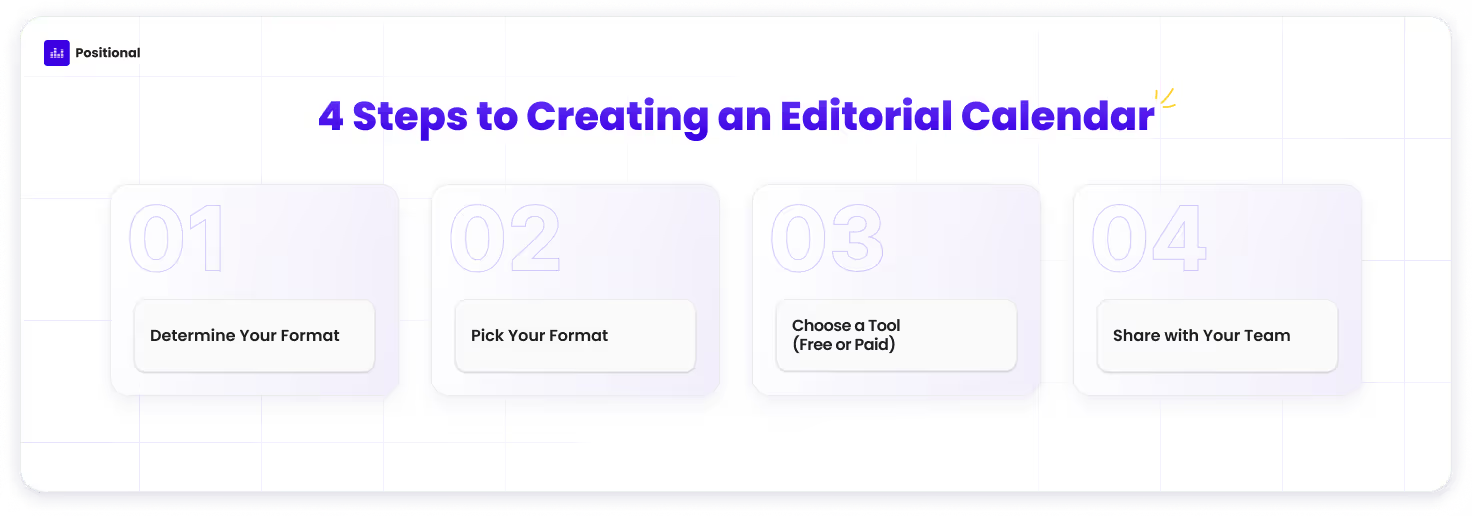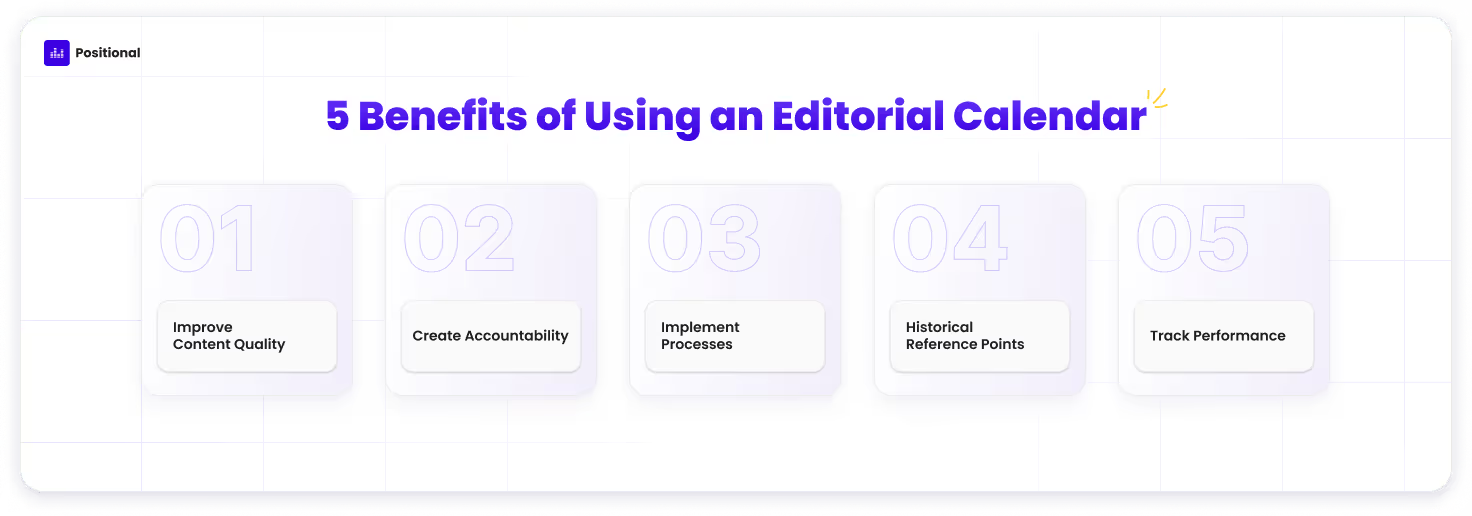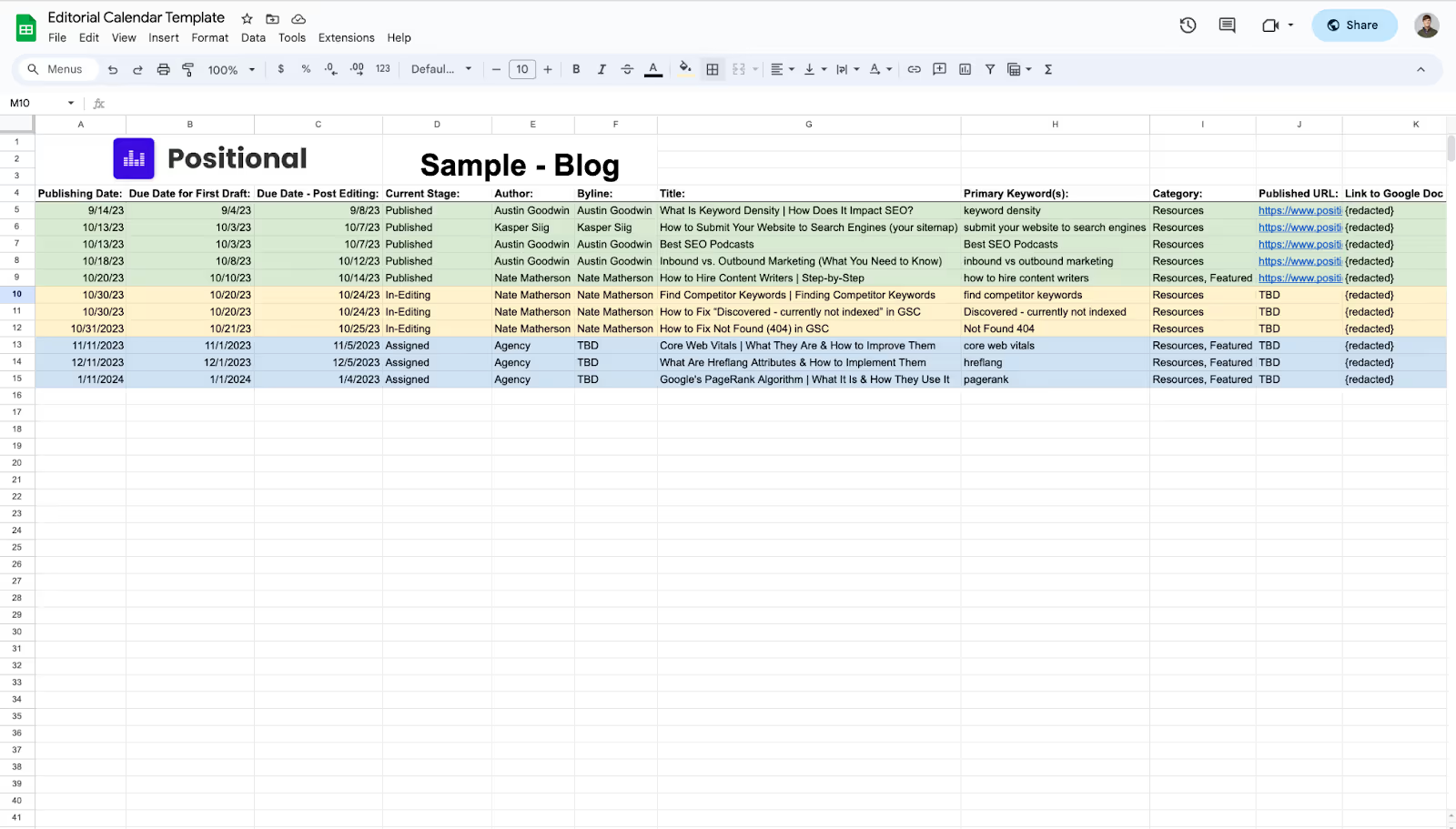Consistency is key when it comes to building your content marketing strategy. And having a well-thought-out editorial calendar will help you do that — it’s mission-critical for starting and scaling your channel.
When it comes to content, there’s a lot to do every day: creating new blog posts, developing outlines, hiring content writers, copyediting newly received work, going back to update and improve previously published posts, and much more. With so much to do, an editorial calendar will keep you and your team focused and hitting your goals.
Editorial calendars come in many forms. And there is no one-size-fits-all approach. In this article, we’ll explain what an editorial calendar is, the step-by-step process for creating one, and the long-term benefits of using one. In addition, we’ll provide a copy of our editorial calendar, with examples from our website, as a template you can use.
What Is an Editorial Calendar?

An editorial calendar is a visual representation of the workflow and schedule of a content creation team: the “source of truth” when it comes to dates and responsibilities.
Creating content isn’t easy, and there are often many steps to keep track of — from ideation to editing to fact-checking and then publishing. An editorial calendar maps out the different steps of the content creation process and will typically provide information like due dates for each step, authors, distribution channels, and keywords to optimize content for.
Creating an editorial calendar is often a collaborative process across a team. The calendar helps keep the team accountable for the work they must complete and the deadlines they need to meet.
4 Steps to Creating an Editorial Calendar

Creating an editorial calendar can be broken down into four main steps.
Step 1: Determine Your Format
When it comes to formatting your calendar, there are a few different directions to choose from.
In essence, you’re creating a calendar, so it might make sense to format the editorial calendar as a calendar.
You could also use a project management tool as an editorial calendar. These tools let you track projects, stage by stage, along a horizontal scroll. They also typically offer a calendar view.
However, many teams opt to keep things simple — especially when they are small or just starting out — using a simple spreadsheet with columns for the different inputs and rows for each piece of content.
At Positional, our editorial team opted for a simple spreadsheet-like experience, and we’d recommend that you start there, too. A simple spreadsheet is great because no one needs to spend time learning to use a new tool, so all team members, whether in-house or freelance, should be able to get up to speed quickly.
Step 2: Pick Your Inputs
Regardless of the formatting you use for the calendar, you’ll want to think critically about the different inputs or columns in your editorial calendar.
As an example, our editorial team uses the inputs listed below in our editorial calendar spreadsheet. We are primarily creating blog content, typically for SEO, and we work with several freelance writers and editors during this process.
- Publishing Date: This is the date on which we expect to publish the piece of content on our website.
- Due Date for First Draft: This is the date our team should receive a copy of the first draft. Some editorial teams will build in a day or two of buffer here.
- Due Date - Post Editing: Our blog content goes through a copyediting process before publishing. This is the date we expect to receive the edited copy from our freelance copy editor.
- Current Stage: We have seven stages in our content creation process. We use Idea, Outlining, Outlined, Assigned, In-Editing, Ready For Publishing, and Published as our stages.
- Author: This is the name of the author or creator of the piece of content.
- Byline: This is the name of the person credited with writing the published piece. Most often, the byline is the author's name, but it could be different if a writer is ghostwriting content for another member of your organization.
- Title: This is the working and then final title of the piece of content.
- Primary Keyword(s): This is often a single keyword or the primary keyword of the piece of content. We may include additional keywords for optimization in our content outline.
- Category: This is the category where the content will be published on our site.
- Published URL: This is a hyperlink to the live version of the content on our website.
- Link to Google Doc Outline: This is a hyperlink to our content outline, which we host in Google Docs.
- Link to Google Doc Copy: This is a hyperlink to the final draft of our content, which we host in Google Docs.
- CTA Description: This is a description of the type of CTA included into the webpage.
- Notes: This is a catchall section for notes from different team members during the content creation process.
Step 3: Choose a Tool (Free or Paid)
There are so many options when it comes to editorial calendar tools. As mentioned above, most teams start with a free solution like Google Sheets. Another popular option is to build an editorial calendar using a lower-cost solution like Airtable or Notion, which offers free tiers and then relatively low-priced options.
Airtable is great if you’re looking for more advanced workflows and stages in your editorial calendar. You can also integrate data sources, like Google Analytics, for tracking performance directly in an Airtable editorial calendar.
Several paid options are built for this specific use case. At Positional, we’re launching an editorial calendar feature within our toolset that functions similarly to Google Sheets but works directly within your content creation workflow. Tools like CoSchedule are built for this exact purpose and allow for multiple integrated calendars across your different content channels — for example, social media and blog content.
There are also project management tools like Monday.com or Asana that you can use to track the different stages of your content production process.
Step 4: Share with Your Team
Getting buy-in on your new editorial calendar from the entire team is important. If you’re working with a combination of in-house and freelance team members, make sure to set up an onboarding session for all members of the team.
You’ll want to walk through the different inputs or stages and ensure that everyone knows which parts of the editorial calendar they’re responsible for editing and which parts are off-limits or would need approval — for example, you might limit the number of people who can change a publishing date.
Sharing the editorial calendar with your team is relatively easy if you work within a platform like Google Docs or Airtable. Simply invite members of your team to join!
5 Benefits of Using an Editorial Calendar

There are many benefits to using an editorial calendar, five of which are very clear.
1. Improve Content Quality
Content quality is more important than it has ever been, at least when it comes to performing well in search engines. However, maintaining content quality standards becomes increasingly challenging as you ramp up content creation.
You can build quality assurance into your editorial calendar and content creation process. For example, as shown in the example above, including the outlining and editing processes in your editorial calendar can help keep your team consistent and on track.
2. Create Accountability
Sticking to a regular publishing cadence is critical. An editorial calendar can help teams stay accountable to deadlines — not just for publishing but also for internal deadlines leading up to publishing.
For example, you can set internal deadlines for milestones such as:
- Outline creation
- First-draft submission
- Post-editing submission
The strongest content teams set deadlines for every part of the content creation process. An editorial calendar can help you stick to these deadlines and hold each team member accountable to their specific deadlines, from ideation to publishing with the CMS.
3. Implement Processes
An editorial calendar is a great place to implement and track the more nuanced steps in your content creation process.
For example, companies in the healthcare industry may implement an in-depth fact-checking process and a clinical-review process. Or say each piece of content on your website needs a featured image before it can be published: this means you should probably track the processes of creating graphics or sourcing images for your posts.
4. Historical Reference Points
An editorial calendar will act as the historical view for all content creation. By clearly labeling, for example, the primary keyword of each piece of content, your team will be able to avoid duplicate content and keyword cannibalization issues.
If you have a large amount of content on your website today but haven’t been tracking it in an editorial calendar, you should go back and build a catalog of all existing content.
Without a historical record, a common mistake companies make is that they will create the exact same piece of content multiple times. This doesn’t sound like a problem for small teams, and it isn’t, but as websites grow, they often accumulate hundreds or thousands of pages — so it becomes impossible to remember all of the pages that exist on the website. And new team members will have no way of knowing everything that’s on the site.
In a case like this, the team’s time would be well spent going back to existing content and refreshing it. You can track this process in your editorial calendar, too, and determine a cadence for going back to revamp existing content.
5. Track Performance
Tracking performance is critical for content marketing teams. And you’ll want to have performance data easily accessible.
If you use Google Sheets for your editorial calendar, you can integrate Google Analytics directly into your sheet using the add-on. You can also integrate Google Search Console into your Google Sheets.
As a separate note, tracking performance or KPIs for an SEO team is often quite challenging. Start by setting KPIs on the inputs you can control — for example, new content production — and then look at the leading indicators that your channel is working: for example, an increase in search impressions to your pages.
Editorial Calendar Template & Example

Initially, many companies like to keep things simple (and free) by using a spreadsheet. We’ve built a Google Sheet that you can use as a template for your editorial calendar.
Included in our editorial calendar template are a number of the important fields mentioned above; for example, there are columns for publish date, due date, author, topic, primary keyword(s), audience, and CTA description, as well as a place for you to include an outline for that piece of content.
Here’s a Link to Our Free Editorial Calendar Template
Simply click on this link to the template and then copy it as a new document in Google Sheets, or download it directly if you want to work in Excel.
Final Thoughts
Creating an editorial calendar is an essential early step for most content marketing teams. Your editorial calendar will be the source of truth for your team when it comes to deadlines, and it will help keep everyone accountable. You can also integrate several data sources into your editorial calendar — for example, Google Analytics or Google Search Console — to track the performance of your content over time.
There are plenty of tools that you can use to set up your editorial calendar — for most teams, using something simple (and free) like Google Sheets is an excellent first step. In this article, we provided a template you can work from in Google Sheets. Included are real-life examples from our editorial team.
At Positional, we’ve built tools for content marketing and SEO teams. Included are a number of features for keyword research, content optimization, and tracking the performance of your content over time.





